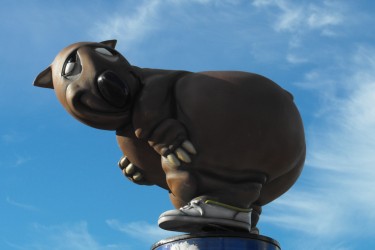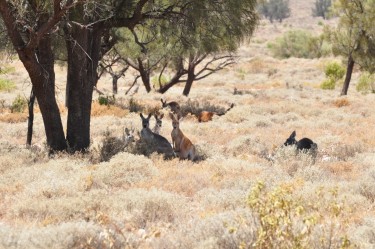 Kangaroos, koalas, wombats, echidnas, platypus(es??? – platypodes?), emus, wallabies, and more kangaroos. Everyone loves Australian animals.
Kangaroos, koalas, wombats, echidnas, platypus(es??? – platypodes?), emus, wallabies, and more kangaroos. Everyone loves Australian animals.
What’s not to love – they’re cute, cuddly, and they sleep in the shade all day – or swim in the case of platypus. And as long as they’re not spiders, snakes or crocodiles, or octopuses or some fish, or jelly fish, they’re unlikely to kill you. Though that’s not impossible either!
I once took somebody on an outback tour and her first priority? “I want to see a kangaroo”.
So where are the best places to see them?
Kangaroos
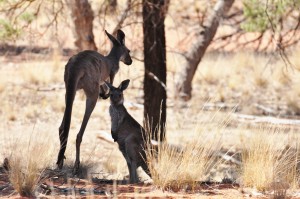 Kangaroos are probably the most instantly recognizable Australian animal, and appear on our coat of arms. There are lots of different types of kangaroos, though the most well-known are probably eastern greys and big reds. Red kangaroos are found in central and north-western Australia, and eastern greys as the name implies are found in the eastern states – Queensland, NSW, Victoria and Tasmania. There are also western greys, which is what you’ll find on Kangaroo Island in South Australia. Western greys are also found along the southern parts of Australia and overlap territories with eastern greys in the Murray-Darling basin region on NSW and Victoria.
Kangaroos are probably the most instantly recognizable Australian animal, and appear on our coat of arms. There are lots of different types of kangaroos, though the most well-known are probably eastern greys and big reds. Red kangaroos are found in central and north-western Australia, and eastern greys as the name implies are found in the eastern states – Queensland, NSW, Victoria and Tasmania. There are also western greys, which is what you’ll find on Kangaroo Island in South Australia. Western greys are also found along the southern parts of Australia and overlap territories with eastern greys in the Murray-Darling basin region on NSW and Victoria.
I know you’ve probably seen the youtube video of kangaroos fighting in the street, but that is an aberration. You really don’t see kangaroos jumping down the streets of our major cities, nor do we ride them to work or keep them as pets.
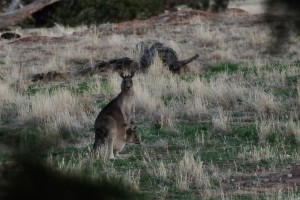 But you don’t have to go far from the city to see kangaroos. We get them in huge mobs (50 or more) at the farm in rural NSW, and I’ve spotted them grazing beaches on the NSW south coast only an hour or so drive from Sydney. They’re also in front of the Cable Beach Bar in Broome WA every evening, at Cradle Mountain in Tasmania, and all over outback NSW and Queensland, sometimes in huge numbers.
But you don’t have to go far from the city to see kangaroos. We get them in huge mobs (50 or more) at the farm in rural NSW, and I’ve spotted them grazing beaches on the NSW south coast only an hour or so drive from Sydney. They’re also in front of the Cable Beach Bar in Broome WA every evening, at Cradle Mountain in Tasmania, and all over outback NSW and Queensland, sometimes in huge numbers.
In fact, kangaroos can be so prolific in areas that I have almost fallen over one. I was wandering up the hill beside the house at the farm very early one morning to watch the sunrise. As I walked I was looking out over the dam, and across to where the sun would come up, working out the best place to stop for photos. As I neared the top I turned around, and right in front of me was a kangaroo. If I reached out I would have been able to pat it, but I was far too surprised to reach out, and so was the kangaroo when it realised I was there. I jumped backwards. It leant back on its tail, but fortunately did not rear up. Lucky for me it did a quick about turn and jumped away. As did its two friends who were nibbling on the grass 10 feet or so from us.
On a recent trip through outback NSW & Queensland and out to Uluru we saw lots of eastern greys and a few reds, in both NSW and Queensland. The last one we saw was well on the Queensland side of the border before we crossed into the Northern Territory, then we didn’t see another kangaroo until we crossed back into Queensland 3 ½ weeks later, and it was only about 1 km into Queensland. We saw wallabies in the Territory, but no kangaroos, not even a big red.
While kangaroos might look cute and cuddly, and you will be able to pat them in a zoo or wildlife park, watch out. Those back legs are very strong and their claws will rip you to shreds. That’s how kangaroos fight – they balance themselves on their tails and use their back legs to tear holes in each others’ bellies.
Koalas
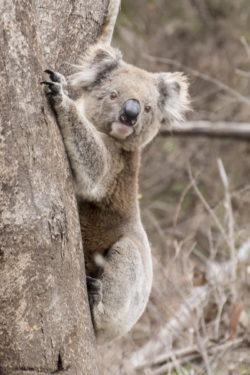 Despite what you’ve been told, koalas are not ‘bears’, but are in fact related to wombats. They are solitary creatures and spend most of their time (up to 20 hours/day) asleep up gum trees.
Despite what you’ve been told, koalas are not ‘bears’, but are in fact related to wombats. They are solitary creatures and spend most of their time (up to 20 hours/day) asleep up gum trees.
They’re difficult to spot in the wild, and most people will only see koalas when they venture into populated areas. The only ‘wild’ koala I’d previously seen was in the car park at the Noosa Surf Club. Doc’s son used to have one that came to visit his school at Port Macquarie, and I’ve had reports from other people who live in or near bushland that koalas will wander into their backyards. My sister lives on the outskirts of Adelaide and she regularly sees them while out walking her dog.
I’ve never seen one in the ‘wild’, nor have I spoken to anybody else who has. Never having seen one, that is not my photo on the right. I HAVE NOW SEEN A KOALA IN THE WILD. More than one. And that is now my photo
S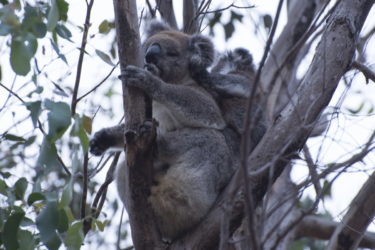 o, where did I see it? On the truly amazing Kangaroo Island. My sister and I went for one of our sisters weekends, and stayed at Flinders Chase National Park. On the morning of our first full day there we went for a long bushwalk through the park. We were standing very still and quiet watching the river trying to spot a platypus (which I still haven’t seen). There were bubbles in the water by the bank so we were sure it was there. Then we heard a crashing through the bush and both got a bit annoyed because it would scare the platypus (that we hadn’t yet seen). I thought it was a kangaroo until it walked onto the track about 10m from where we were standing. I’m not sure who was more startled, me or the koala, which Eleanor hadn’t notices as she was still looking to see the platypus. The koala and I looked at each other for what seemed like a very long time. “Eleanor, Eleanor” I stage whispered to get her attention and not scare the koala. “Shh” she said. “Eleanor!” I dramatically whispered “k … k.. ko … koala!”. The koala made a beeline for the nearest tree and jumped onto the trunk. That’s it. Just jumped. It didn’t climb. It just clung to the trunk staring at us. I was so excited I could barely hold the camera still to take a photo.
o, where did I see it? On the truly amazing Kangaroo Island. My sister and I went for one of our sisters weekends, and stayed at Flinders Chase National Park. On the morning of our first full day there we went for a long bushwalk through the park. We were standing very still and quiet watching the river trying to spot a platypus (which I still haven’t seen). There were bubbles in the water by the bank so we were sure it was there. Then we heard a crashing through the bush and both got a bit annoyed because it would scare the platypus (that we hadn’t yet seen). I thought it was a kangaroo until it walked onto the track about 10m from where we were standing. I’m not sure who was more startled, me or the koala, which Eleanor hadn’t notices as she was still looking to see the platypus. The koala and I looked at each other for what seemed like a very long time. “Eleanor, Eleanor” I stage whispered to get her attention and not scare the koala. “Shh” she said. “Eleanor!” I dramatically whispered “k … k.. ko … koala!”. The koala made a beeline for the nearest tree and jumped onto the trunk. That’s it. Just jumped. It didn’t climb. It just clung to the trunk staring at us. I was so excited I could barely hold the camera still to take a photo.
That evening we went for a walk in a wildlife sanctuary and saw lots more koalas. Many with babies. It was amazing, but it wasn’t as exciting as our first truly wild koala.
So if you can’t get to Kangaroo Island, you’ll be able to see them in wildlife parks and zoos, but you can no longer hold them, at least not in NSW. And stay away from them in the wild if you’re lucky enough to see one. They have sharp claws, and as a previous Federal Minister for Tourism famously said, they are “flea-ridden, piddling, stinking, scratching, rotten little things”. And many have chlamydia.
But they are cute!
Fatso the Fat-Arsed Wombat is everybody’s favourite wombat. He was the unofficial mascot of the 2000 olympic games in Sydney, appearing on Roy & HG’s spoof television coverage of the Olympics “The Dream”.
There are two types of wombats – common wombats and hairy-nosed wombats. The name should give away the difference between the two. You can find common wombats (or bare nosed wombats) down the east coast of Australia from Brisbane to about Melbourne, and inland to the mountains, as well as throughout Tasmania and Flinders Island. Southern hairy-nosed wombats can be found around the coast of South Australia, and northern hair-nosed wombats are left in one very small part of outback Queensland only.
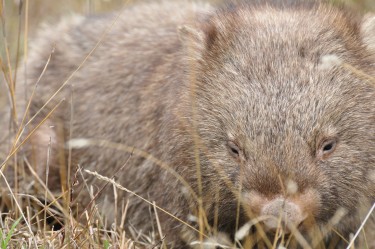 Wombats are nocturnal animals, so you are unlikely to see one out during the day. But if you go spotlighting in wombat territory, or wander around with a torch, your chances of seeing them are very high. I’ve seen five in one night in one paddock at the farm, including one pair – the only time I’ve ever seen two wombats together.
Wombats are nocturnal animals, so you are unlikely to see one out during the day. But if you go spotlighting in wombat territory, or wander around with a torch, your chances of seeing them are very high. I’ve seen five in one night in one paddock at the farm, including one pair – the only time I’ve ever seen two wombats together.
My experience is that as long as you don’t get too close they’ll continue to meander around, sniffing the grass, eating, and exploring. But if they sense you are close they will run away and hide, and they can run a lot faster than you would expect. The light doesn’t seem to bother them too much, and I’ve sat for 10 minutes or more with a light shining on one wombat, watching it do its thing.
Unfortunately if you do see a wombat out during the day, it probably has mange.
That’s it for today. Tune in again tomorrow for the best places to see emus, platypuses, wallabies, echidnas and other strange creatures you might see in the outback.

